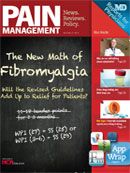Publication
Article
Pain Management
Pediatric Pain Medicine: May 2011 News Roundup
A brief look at interesting and noteworthy studies and articles addressing various issues in the diagnosis and management of pain in children.

No Evidence of Negative Long-term Neurocognitive Development Effects from General Anesthesia?
Results from animal studies have raised concerns over the possible harmful effects of anesthesia on long-term brain development in children. The authors of “Academic Performance in Adolescence after Inguinal Hernia Repair in Infancy: A Nationwide Cohort Study,” published in the May 2011 issue of Anesthesiology (http://HCP.LV/lCndIo), note that because “virtually all general anesthetic agents used in clinical practice are implicated” by these results, the pediatric anesthesiology community has proposed a variety of means for further investigation of the “possible neurotoxic effects of anesthetics in surgical neonates and infants.” This study, which looked at academic performance in children who had undergone general anesthesia during surgery for inguinal hernia repair, found “no evidence that a single, relatively brief anesthetic exposure in connection with hernia repair in infancy reduced academic performance at age 15 or 16 yr after adjusting for known confounding factors.” 
Evidence-based Pediatric Pain Management in Rural Emergency Departments
A study published in The Journal of Pain (http:// HCP.LV/kzB5OX) that used a Web-based survey to explore whether nurses and physicians in rural emergency departments consistently follow evidence-based pediatric pain management practices found that “the majority of respondents infrequently used any type of topical analgesic before venipuncture or IV insertion in children, or oral sucrose for infant procedures.” Practitioners in rural emergency departments “used a topical analgesic for suturing lacerations, provided analgesics for blood draws, and gave pain medication to children with abdominal pain” far less frequently compared to their counterparts in urban emergency departments. The differences were even more pronounced when the authors looked only at the evidencebased pediatric pain management practices of nurses in rural vs. urban emergency departments. 
A Multidisciplinary Approach to Pediatric Chronic Pain
Chronic pain is more common among children than is perhaps generally assumed by nonpediatric pain specialists. Tracy Harrison, MD, writing in the March 2011 issue of Minnesota Medicine (http://HCP.LV/ldDEfH), notes that studies have shown that up to 46% of children worldwide have experienced pain on a daily basis for more than three months, with headache, abdominal pain, and musculoskeletal pain as the most common causes. Chronic pain in children, especially untreated or undertreated chronic pain, can have a severe negative impact on a child’s school attendance, ability to socialize with friends and peers, and the ability to engage in physical play and other activity. Chronic pain has also been associated with increased risk for anxiety and depression in children. Harrison suggests that for children whose pain “proves to be chronic and is beyond the scope of their primary care provider,” a multidisciplinary approach to pain management is preferable, including specialist who have “experience in evaluating and treating particular pain syndromes to rule out lifethreatening or readily treatable conditions.” Studies and the experience of pediatric pain clinics support a multimodal approach to treatment that incorporates pharmacologic and nonpharmacologic interventions. When prescribing medication for pain in children, Harrison notes that the World Health Organization and others recommend “overthe- counter medicines before prescribing more potent drugs.” Although opioids have been shown to help improve pain symptoms in many adult patients, Harrison cautions that “there is no literature pertaining to opioid use for chronic pain in children” and “few studies have looked at whether their use leads to improvement in functioning” in adults. 
Recurrent Abdominal Pain in Children
Noting that “functional abdominal pain” is “the most common diagnosis of chronic, idiopathic, abdominal pain in childhood,” the authors of “Abdominal Migraine: An Under- Diagnosed Cause of Recurrent Abdominal Pain in Children,” published in the March issue of Headache: The Journal of Head and Face Pain (http://HCP.LV/mBnLpW), conducted a retrospective chart review on patients referred to an academic pediatric gastroenterology practice to determine why abdominal migraine (AM) remains “an under-diagnosed cause of chronic, recurrent, abdominal pain in childhood in the USA.” During chart review of 458 children with recurrent abdominal pain, the authors used the International Classification of Headache Disorders (ICHD-2) to identify children who met the diagnostic criteria for AM. Although they identified 20 cases (4.4%) that met ICHD-2 criteria for AM and another 50 (11%) that had “documentation lacking at least 1 criterion, but were otherwise consistent with AM,” not one child seen in the practice had received a diagnosis of AM. The authors noted that “given the spectrum of treatment modalities now available for pediatric migraine, increased awareness of cardinal features of AM by pediatricians and pediatric gastroenterologists may result in improved diagnostic accuracy and early institution of both acute and preventative migraine-specific treatments.”
